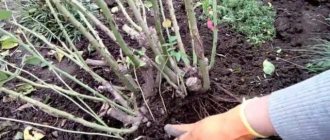Is it possible to germinate a rose from a bouquet?
For propagation in this way, flower cuttings taken in early summer are most suitable. The best time is June. You can do this at the end of summer, but it will be more difficult to achieve results. It is most problematic to achieve the emergence of a root system and preserve seedlings until spring in autumn and winter. Rooting 30% of seedlings in winter and 70% in spring is an excellent result. In summer, the chances of roots appearing increase to 90%.
—
Which roses from the bouquet are suitable:
- not fully blossomed with a green semi-lignified stem without signs of rotting;
- with developed healthy buds in the leaf axils;
- with the lower part of the stem the diameter of a pencil.
Varietal roses with large buds on fatty shoots are almost impossible to root. Do not delay the process of growing seedlings. Proceed with it after receiving flowers: a wilted and faded plant very rarely takes root.
Rooting also depends on the type of flower. The following roses take root quite well:
- polyanthaceae;
- ground cover;
- small-flowered;
- miniature.
Climbing roses, fine roses, and grandifloras are the worst suited for obtaining seedlings. The probability of floribunda stems rooting is 50%. Park roses take root most poorly.
If the bouquet is made up of local varieties, then the emergence of the root system will occur quickly and without problems. When growing roots on flowers brought from abroad, the chances of successful rooting are only 40%. This is explained by the fact that plants are treated with hormones that inhibit the wilting process, but they also delay the process of root emergence.
Red and white roses have a higher degree of rooting, unlike yellowish and fawn roses
It may turn out that a cutting of an exquisite rose of an unusual shade will produce simple pink or yellow flowers. It is likely that the parent plant was a hybrid bred for certain properties. During vegetative propagation, daughter shoots rarely retain their selection qualities.
Reproduction at different times of the year: summer, autumn and winter
Cuttings can be carried out at other times of the year: the young plant can take root, but with great difficulty.
The end of summer and the beginning of autumn is a bad time for cuttings, since the rooted young shoot will not have time to gain enough strength on the eve of winter and may simply die.
From October to February there is a period when the rose rests, and all processes in the plant proceed slowly. Therefore, cuttings will most likely also fail.
You can try to correct such situations by providing additional illumination of the plant and cuttings, but this step will not give a 100% guarantee of success. For those wishing to carry out cuttings in the fall, we have prepared separate material.
Optimal conditions for root emergence
The roots of rose seedlings appear after about a month. With any cutting method, it is important to maintain a temperature of about 20 degrees and high atmospheric humidity until this moment. Future roses should not be kept in bright sunlight to avoid burns. If they are in a greenhouse or greenhouse, ventilation is required in the morning and evening.
Use of growth stimulants
Soaking with a special biostimulator accelerates the appearance of roots. If it is purchased, you need to keep the stems for six hours.
Purchased products to stimulate root growth:
| Biostimulating drug | Correct proportions of solution (product/water) |
| "Kornevin" | 1 gram per liter |
| "Radifarm" | 2 drops per liter |
| "Heteroauxin" | 1 tablet per 2.5 liters |
| "Epin extra" | 1 ampoule per 2 liters |
| "Zircon" | 1 milliliter per 10 liters |
When using Radifarm, the soaking time is reduced to half an hour - the drug is very active. You can use traditional methods - an aqueous solution of aloe juice (9:1) or water with honey (dissolve a small spoon in 500 ml of water). Then the soaking process is extended up to 24 hours.
Germinating roses from a bouquet in water: instructions
This method is simple and accessible. Its effectiveness depends on the quality of the water. If it is not of sufficient quality, the stems will rot. The most suitable is spring or melt. Tap water must be filtered and left to stand for 24 hours.
The most suitable water for roses is spring or melt water.
The step-by-step instructions here are simple:
- Pour water into the container so that the ends of the cuttings are submerged a quarter of the way.
- Place the stems in water.
- Place the jar in a slightly shaded place.
It is better to choose a container made of dark glass or plastic, but if this is not available, a regular three-liter bottle will do.
Water replacement is carried out every two days. After three to four weeks, whitish thickenings - calli - will appear at the bottom of the cuttings. Then the roots will “hatch”.
Video: rooting cuttings in water
Rooting methods
If you ask experts which rooting option is better, you will hear several answers. Indeed, for one gardener the easiest is in water, for another - in soil. Many people prefer to germinate roses in potatoes, in a bag or in a roll of newspaper. It is best to try different ones and choose the one that gives the result.
You will find detailed information and tips on rooting cuttings in various ways in the articles “How to propagate an indoor rose at home” and “Roses cuttings” on our website.
Cuttings that take root in the fall are provided with greenhouse conditions with artificial supplementary lighting for the winter.
Other germination methods
You can achieve the appearance of roots in other ways. Some gardeners believe they are even more efficient than using water.
In pots
For each future rose you will need a 500 ml pot and soil mixture. If it is purchased, it is better to choose one that is suitable for roses and violets. You can prepare the soil yourself - mix garden soil and sand in a 2:1 ratio and disinfect the resulting soil. When planting several cuttings in a large container, the step between them should be at least 6 cm.
The fact that roots have appeared will be indicated by soft green shoots on the stems
How to plant cuttings correctly:
- Wipe the inside of the pot with potassium permanganate to disinfect, place small pebbles on the bottom for drainage, then add soil.
- Dig a small hole, place the stem, fill and compact the soil, and water with settled water.
- Cover the potted seedling with a jar or plastic bottle, creating a mini-greenhouse.
When the surface of the soil begins to dry out, spray it with water from a spray bottle. The fact that roots have appeared will be indicated by soft green shoots on the stems. Then the roses begin to harden - adapt to the environment, periodically removing the coating for 5 minutes. This period gradually increases, and when leaves appear, flowers can be planted in open ground. If possible, they should also be accustomed to the street gradually, periodically placing pots on the balcony.
In the package
It is possible to create greenhouse conditions using an ordinary plastic bag without any pots. For this:
- Fill the bag one third full with a suitable soil mixture.
- Treat the bottom cut with a root growth enhancer and place in soil.
- Tie the bag so that the top is filled with air, and hang it near the window.
It is possible to create greenhouse conditions using a regular plastic bag without any pots
Green shoots will indicate the formation of roots. They will appear in two to three weeks. And replanting into the ground can be done after a month.
In the newspaper
This method is called the “burrito method”: the stems wrapped in newspaper look like a Mexican dish. How to cut roses this way:
- Spread the newspaper and place several prepared stems on it. Fold the edges at the cuts and wrap the rest of the paper around the cuttings so that there are no holes in it.
- Wet the resulting roll thoroughly.
- Place the bundle in a plastic bag, tie it and store at a temperature of about 20 degrees.
This method is called the "burrito method"
Unroll the roll once a week to check. If rot appears, the newspaper needs to be changed, leaving only healthy copies. After this, the bundle must be moistened abundantly again. The appearance of roots can be expected after two to three weeks.
Using potatoes
Using tubers to root cuttings is an effective and low-cost method. Future roses will receive the necessary nutrients and moisture for root formation from the tuber.
Using tubers to root cuttings is an effective and low-cost method
To create seedlings, you will need medium-sized potatoes, without signs of rot, wilting or damage. There should be no sprouts or green areas of the peel on them. The tubers must be thoroughly washed and treated with potassium permanganate for disinfection.
How to germinate a pink cutting in a potato:
- Cut a hole in the tuber that matches the diameter of the stem. The bottom of the recess should be about a centimeter thick.
- Treat the cut of the cutting with a biostimulant and place the stem in the hole.
- Fill a 500 ml container with soil one third of the way, put the potatoes in there and sprinkle with soil. Water it.
- Cover with a jar or plastic bottle to create a greenhouse effect.
Next you need to proceed as when growing seedlings in pots. But experienced gardeners say that rooting occurs faster - after two weeks.
Video: roses in potatoes
What are the advantages of cuttings?
Growing rose bushes by cuttings has a number of advantages, namely:
- A new crop is able to preserve the characteristics of the mother plant, so even before planting the cuttings in the soil, you can immediately understand how the flower will turn out.
- No stems on the sides. During development, the rose will not branch.
- If propagated correctly, the plant will bloom within 10 years.
- You can get several cuttings from one bush.
- Rose cuttings take root easily.
What is noteworthy is that cut rose cuttings can remain viable even after long-term transportation. Therefore, this method of reproduction is the most popular.
Caring for sprouted cuttings before planting in open ground
If your cuttings have roots, but the buds have not bloomed, then the plant is still dormant. It is better to save them until planting in the garden - until late spring. They are kept in a cool place (temperature from minus four to plus two degrees). Then the seedling will “sleep” until spring.
But pink cuttings, when rooted, can immediately sprout. It is better to remove large ones immediately if planting is still far away. Otherwise, they will suck out all the nutrients and the seedling will die. Especially if you grew a seedling from a bouquet rose, say, in late summer or autumn.
For small sprouts, you can try to store the shoots in the refrigerator or cellar under constant supervision.
You can plant shoots with large sprouts in pots, but they will have to be hardened off, since until spring they will be in more comfortable conditions than outside.
When the cutting is completely ready for planting
After about a month or two, a whitish thickening - callus - forms at the bottom of the stem. It is the basis for the roots. When they reach a centimeter in length, the shoot can be planted in open soil or a pot (if it is not possible to keep it dormant until spring). When cuttings are taken in the ground, roots also appear at this time.
Planting a rooted cutting in a permanent place
Rooted cuttings, regardless of the technique used, are planted in open ground in late spring or early summer. Warm weather should be stable, without possible frosts. You can’t plant cuttings of roses in the fall - they will freeze.
Rooted cuttings, regardless of the technique used, are planted in open ground in late spring or early summer
For future roses, choose a sunny, windless area. How to plant them correctly:
- Loosen the soil and fertilize it with organic fertilizers.
- Leave at least three buds on the stems, and dig a hole slightly larger than the rhizome.
- Water the soil under the seedling and sprinkle with peat or sawdust.
- Create shade from direct sunlight.
Getting used to a new “place of residence” for roses lasts about 2 weeks.
You need to think in advance about covering young roses for the winter to protect them from frost. It depends on the variety. Some need to be dug up and kept cool. Others just need to be trimmed and covered with foliage.
With proper cuttings, planting and care, the former bouquet will turn into a real rose garden.
- Author: Olga Grow
Rate this article:
- 5
- 4
- 3
- 2
- 1
(9 votes, average: 3.1 out of 5)
Share with your friends!










